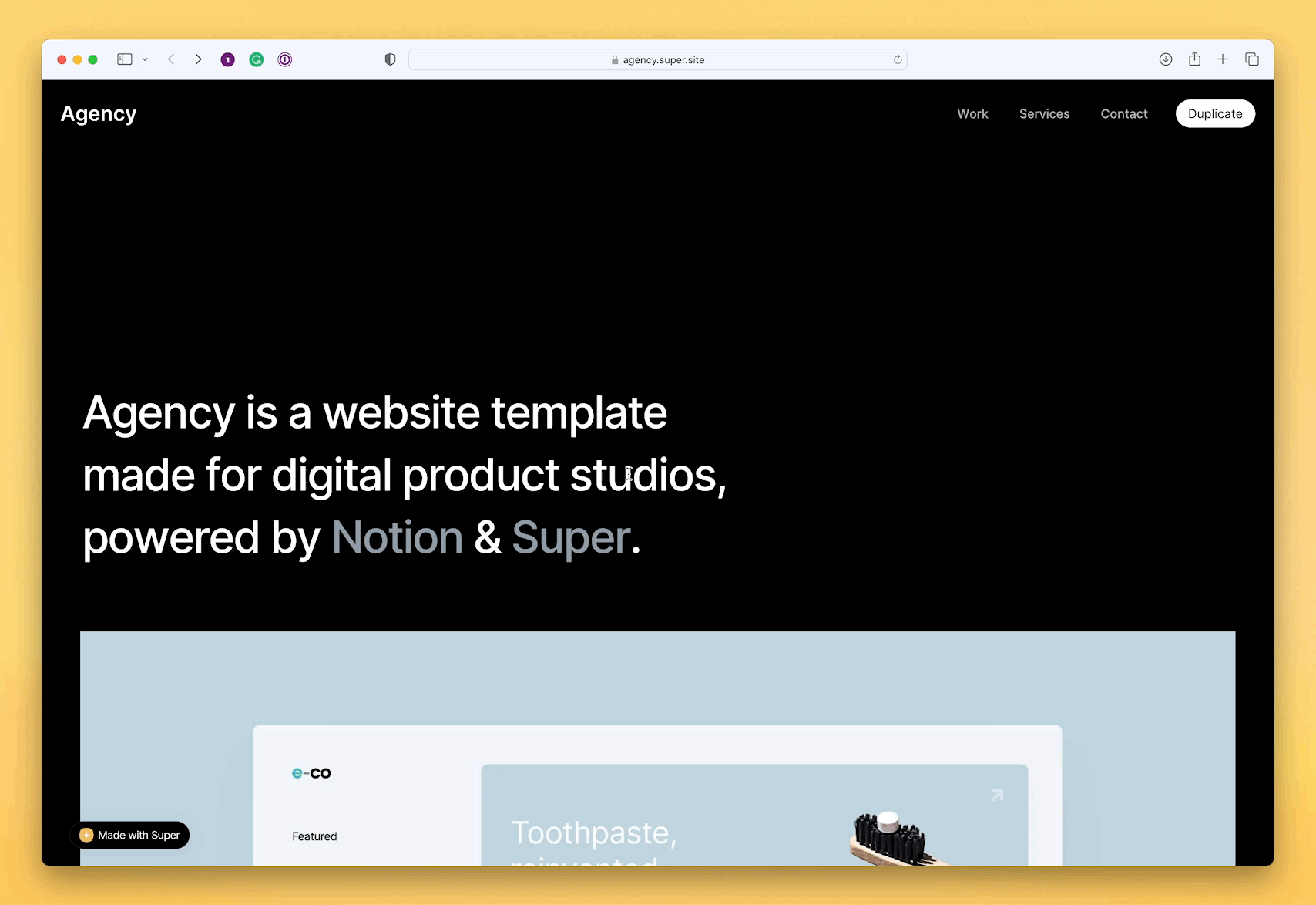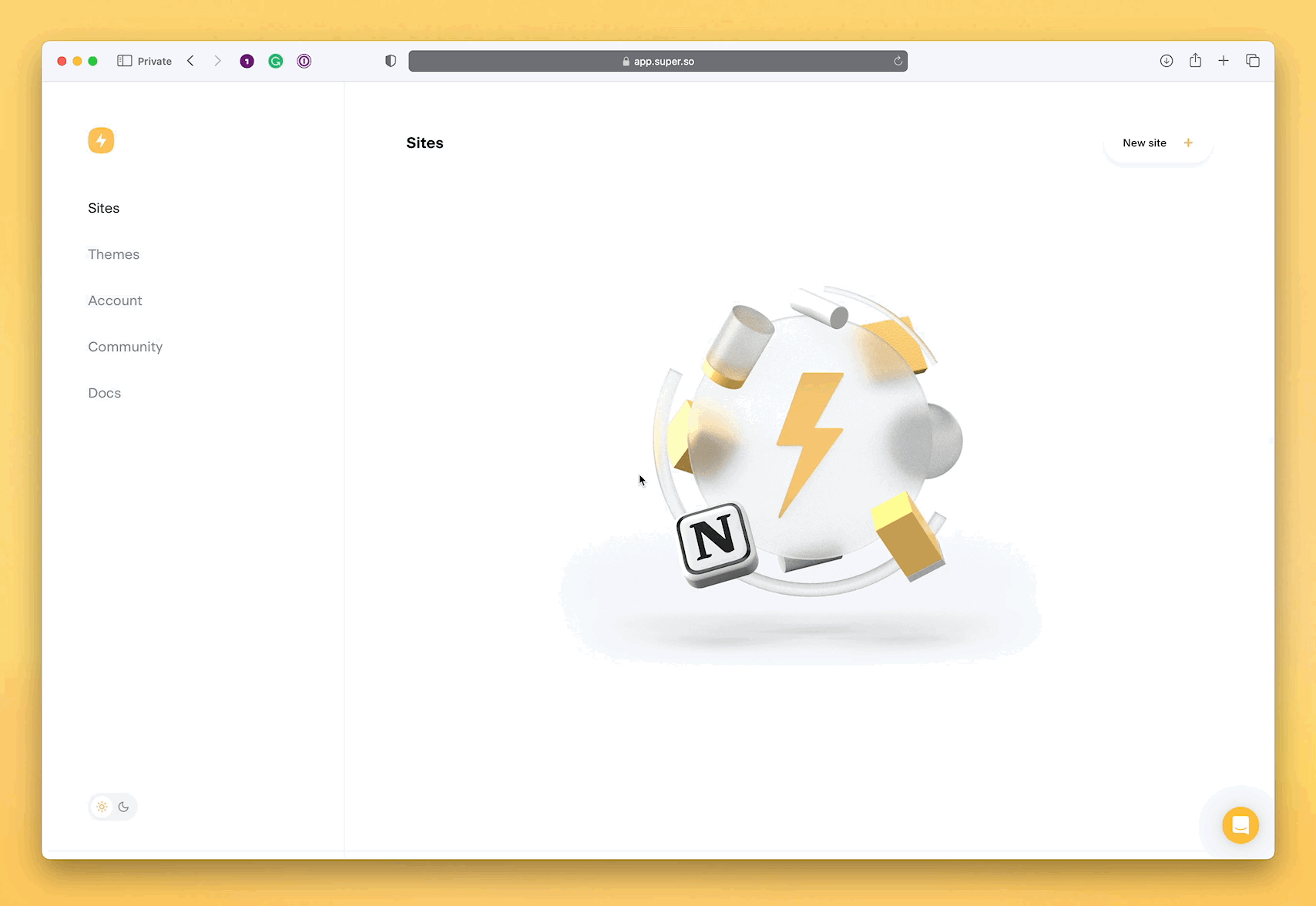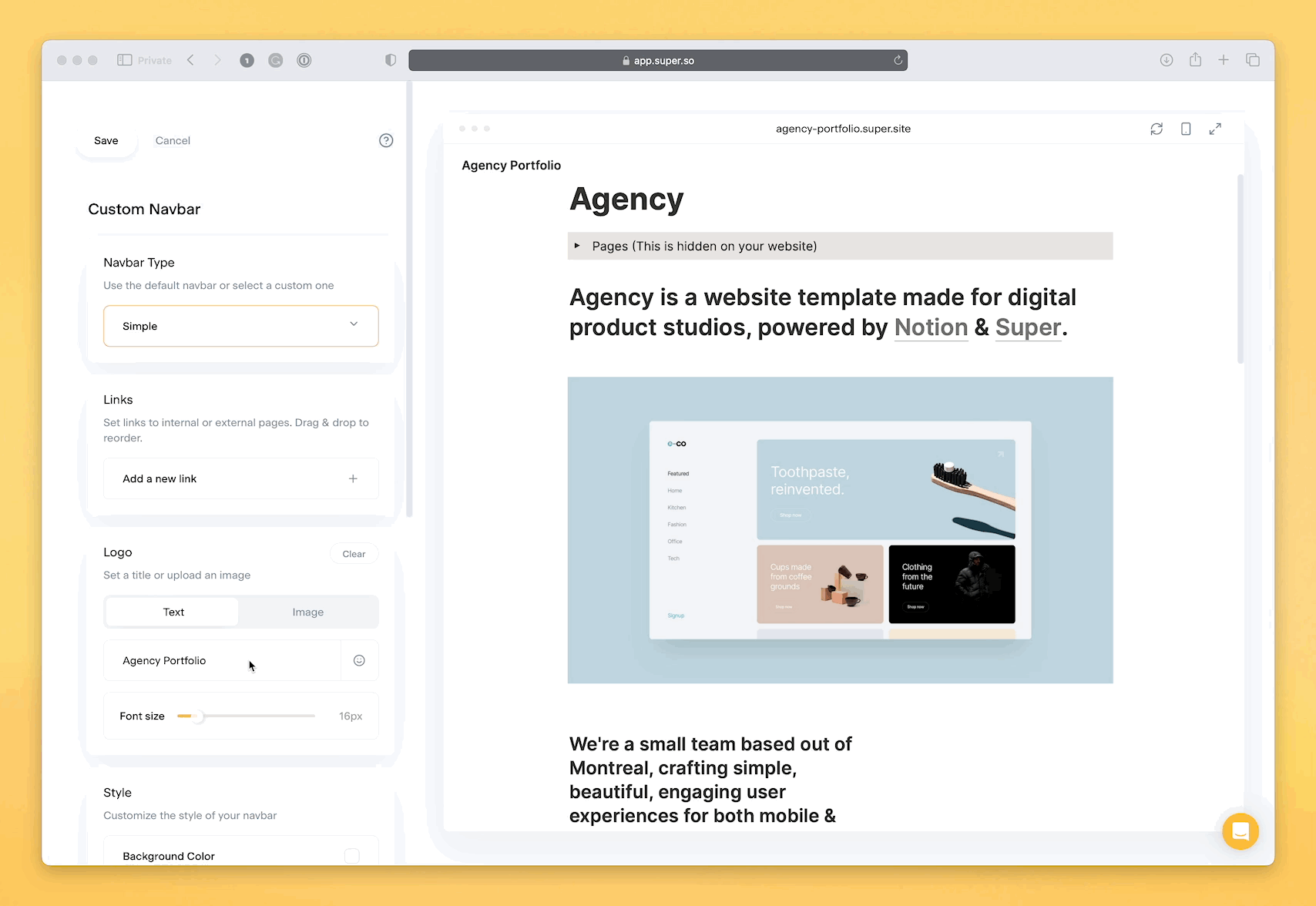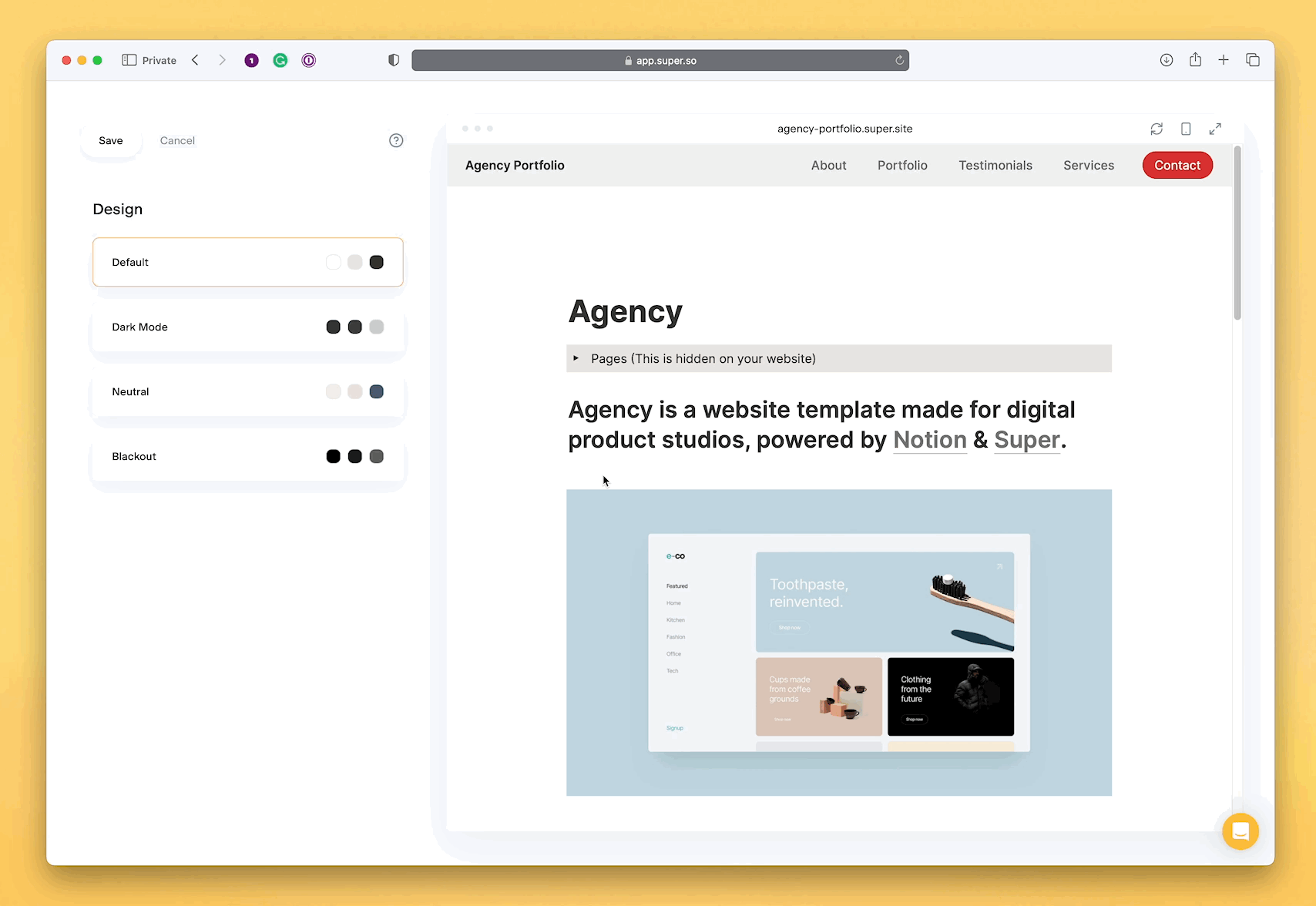The easiest way to build your portfolio on Notion is by using Super. With this Notion portfolio builder, you can create your site in no time without having to write a single line of code.

1. Choose a Notion Portfolio template
The primary purpose of your portfolio is to showcase your work but it serves another important one—establishing your personal brand. Your portfolio website is a glimpse into your personality. It is the first indicator of the quality of work you deliver.
Think from the perspective of someone who is hiring a freelancer. They get hundreds of portfolios per job post from freelancers across the globe. Most pitches land in the trash folder - except those that stand out.
When clients see a professional-looking portfolio site, they spend time exploring it. The more content they consume, the better the chances they reach out to the freelancer. With a neat, organized, and meticulously planned portfolio, you can convince the client that you will replicate the finesse with your deliverables.
The first impression is the best impression - Super will help you deliver that without you having to code.
Super has a collection of nine sleek and professional templates that will help you jump-start your portfolio website. Head to the Super templates page and filter by ‘Portfolio’ to find them.
Explore the templates and pick the one that looks the most like your ideal portfolio. You need not worry about any other aspects of website creation like Page speed and SEO - Super has got you covered.
We will use the Agency template as an example for the rest of this section.
Notion Portfolio Templates and Examples
2. Duplicate the template on Notion and create your first page
Duplicating the template will create a new page in your private Notion workspace. Every sub-page you create becomes a new page on your website. Here’s how you can duplicate your favorite template on Notion:
Step 1: Click on Duplicate at the top-right corner of your template view. Then Click on Duplicate again to copy the template to Notion.

You will find the Agency template copied in your private folder on Notion.

This process takes only 15 seconds.
You can now use the template page just like any other page on Notion.
3. Structure your portfolio page in Notion
Alright, now that you have the duplicated your favourite template, it is time to structure it with the appropriate blocks and visuals before you link it to your Super app.
Keep in mind that Super enhances the professional and aesthetic appeal of your content, but you can only create content in Notion. Begin by selecting appropriate text for the H1 of the page and planning your structure from there. Consider all the items you wish to highlight on your portfolio's homepage; each of these items represents a potential H2. Plan all H2s, and even H3s if necessary, before considering other blocks.
If you want to showcase samples of your work under one of the H2s, consider using the gallery view. This database view allows you to provide a visual representation of your portfolio and attract more attention.
Additionally, try to incorporate as many visual elements as possible, such as quotes and embed blocks, to enhance the visual appeal. These blocks play a pivotal role in keeping visitors’ attention. Remember that the more time a visitor spends on your page, the more motivated they are to reach out to you.
Once you've completed the first draft of your portfolio, ensure that you review it thoroughly. Read each word carefully from the perspective of a potential client. Remember that you can edit any item, reposition it on the page, add new items or delete the existing ones. But, that’s where Notion’s design capabilities end. You can not change the color, font, layout, or anything else that makes your portfolio stand out.
So, once you’re done with the basic layout design, it’s time to customize it to your taste with Super. But you must first publish the Notion page and get the web link.
4. Publish the Notion portfolio page
Click on the Share button at the top-right corner of your Notion screen, then click the Publish tab and press Publish to the Web, and copy the web link. You will need it in the next step.


5. Signup with Super
You can signup with Super for free, but a paid plan will unlock many new features that will help you customize your website even better. The Personal site plan is ideal for anyone creating a portfolio. It will cost $16 per month - $12 per month if paid annually.
After signing up, head to the Super app to set up your portfolio and click on the New site button at the top-right corner of your screen to trigger the create a new site pop-up.


6. Customize your Notion portfolio
Now it’s time to make your portfolio look exactly how you want. Super allows you to modify every element of your website seamlessly - the general look and feel, color, fonts, navbar, or footer. You can tweak anything you want - you have complete control.
Here’s everything design that you can do with Super:
1. Create Navbar and Footer
Navbar gives the most important pages of your portfolio the attention they deserve. It is the first page element that visitors notice, so it must be designed to guide them to the other pages that they might find relevant.
Suppose you are a freelance writer who covers multiple niches. With Super, you can create a subpage for each niche and add them to the navbar. Potential clients can click on the niche they are hiring for and see relevant samples. They need not go through the homepage or spend any time figuring their way around the website. The faster they arrive at the relevant pages, the greater the chance they reach out to you.
Given its importance, you must make sure that the navbar stands out. With Super, you can set up the perfect navbar in no time.

Select one of the three available navbar styles to trigger a view where you can customize the other elements of your navbar.

In this view, you can:
- Add your logo
- Add pages to the Navbar
- Customize background and text color
- Add a shadow to the Navbar
- Add a Call-to-Action (CTA) button that stands out from the Navbar and gets clicks
- Make the navbar sticky to make it accessible even when the visitors scroll

Here’s what a sample navbar looks like on the Agency template.

Just like the navbar, the footer of your website helps you establish your brand. It’s also the last section of the page that people see before they leave your website. The footer plays the important role of showing them something of interest and retaining them in your portfolio for longer.
To set it up, click on the Footer option in the Super dashboard to see the footer view. Then:
1. Choose from three styles of footer
2. Add pages that you want to feature there
3. Add social media icons linking to your social profiles
4. Add your logo
5. Change the background and text color
Here’s what a sample footer looks like in the Agency template.

2. Select a default color theme or create a new one
You now have the navbar and footer ready. It’s time to customize everything else in the middle.
You can change the color theme of your portfolio in a few clicks.
Super offers four custom color themes. Click on the Design option in the dashboard to find them.

Try them out. If you don’t like any, you can create your own theme with your color palette! To do that, head back to the main Design view and click on create a new theme. Name your theme, click on create, and customize all the available design options you see in the image below.

3. Add a custom domain
Your portfolio's domain name is a crucial aspect of your online presence. It serves as the unique identifier for your website. When people look up your name or your portfolio's name on Google, they will see the domain name at the top of the search results.
A unique domain name is essential to establish your online identity - customize it with Super.

The domain name of the portfolio that we created in this article is sampleportfolio.super.site. By signing up with the Personal site plan, you can remove .super.site from the domain name and make the URL look cleaner.
7. Add other page types
Unless you want to create a one-page Notion website, your portfolio will have multiple pages, each with a unique purpose. You can easily add every page type with Super. Lets explore them one-by-one.
1. Create an aesthetic homepage
Your homepage is the face of your portfolio. Most visitors who land on other pages of your portfolio, often want to click on your logo and land on the homepage to gauge your personality. A clean and professional homepage hints that you will handle their requirements the same way. It’s a powerful branding and trust-building opportunity.
Super offers stellar design features that can help make your content in Notion look aesthetic. You can neatly segment your homepage into sections, each of which talk about a certain aspect of your business. You can also highlight samples relevant to different niches right on the homepage!
You can easily add another block to display testimonials from your previous clients and make it render perfectly on your website with Super.
2. Create a blog on your portfolio
Depending on the type of services you provide, you might want to start blogging on your Notion portfolio. When you start writing content about your niche, you stand a chance at getting high-quality organic traffic from search engines, who are looking for the services you offer.
For example, if you are a freelance designer, you can generate leads with topics such as - “How to hire a designer in Austin”, “Questions to ask before hiring a designer”, etc. These topics will attract visitors who already have an intent to hire.
Now that you are using Super, optimizing your blog content for SEO is easy! You can also design the blog the way you want without worrying about impacting the page load speed.
Also, you can repurpose blog content on social media and drive traction from yet another channel! The possibilities are endless.
3. Create an “About me” page
Your portfolio is not just supposed to sell the your services, it should also sell you as a person. Your clients will (hopefully) work with you for months, they do not want to work with someone who is difficult to handle, hard to communicate with, and unreliable. To make sure that you are a professional, they will want to consume more information about you as a person before they reach out to you.
By adding an “About me” page, you humanize your brand. On that page, you can talk about what you like beyond work, your working style, your communication frequency, and other soft skills that make people relate to you better.
An “About me” page can do wonders for your individual brand, and you can create one easily with Super.
4. Create the Contact page
You have sold your capabilities as a freelancer through your portfolio page and your personal brand through the “About me” page. Your future client has decided to reach out to you and discuss their requirement in depth. What they need next is a way to contact you, and that’s where the “Contact” page plays an important role.
Ideally, you want all your visitors to get to this page, one way or another. You should display it on your navbar button, in the footer, in the CTA buttons, etc., without spamming the visitors.
The contact page must include all your social media handles and your email ID to give the visitors a wide range of options to contact you. Additionally, it must load fast and be designed perfectly. You can create the perfect “Contact” page in no time with Super’s aesthetic templates.
Why use Super with Notion for creating a portfolio?
Notion offers basic website creation capabilities but it falls short in key areas that are crucial for a standout portfolio but Super fills those gaps and helps you create a branded, high-conversion portfolio with your content in Notion. Here’s why you need Super on top of Notion to create the perfect portfolio:
1. Integrates with Notion like peanut butter and jelly
Love Notion? So do we! So we have ensured that all your content stays in Notion. Super integrates with Notion to morph your content into a stellar and unique portfolio. The integration is so smooth that all Notion blocks render on Super’s website. In fact, you can customize them even better in Super.
Furthermore, Super-powered portfolios function even during Notion outages, ensuring consistent uptime.
2. As simple as you want it to be but not restrictive
You can build a stellar portfolio in 4 minutes with Super's intuitive dashboard. While you don't need to write code, it's worth mentioning that Super supports custom code. This allows customizing design beyond Super's capabilities.
Notion, on the other hand, does not support custom code - forcing you to work with its basic design features.
3. Craft a brand that truly represents you
Notion can help you create a functional portfolio but not a credible brand. Freelancers use Notion for portfolio creation and inadvertently borrow its trademark design. Their portfolios all look the same and lack soul.
Add personality to your portfolio with Super to avoid looking like a replica of Notion. Use Super's unique fonts and aesthetic colors for differentiation. Add logos, set up a functional navbar and footer to build a powerful personal brand that people trust.
4. Customer support by actual people you can converse with, not bots
Super’s support has evolved over the years. It has a comprehensive knowledge base and detailed user guides for when you run into a fix. Super's functional Discord server and active website building community have all the answers.
But if you are still stuck, reach out to our support team. Our average response is just 10 minutes - you are never more than a few minutes away from help.
5. Stunning templates that go far beyond just getting you started
Notion comes with a handful of identical portfolio templates. All your competitors use the same set of templates, making them copies of each other.
Super, on the contrary, offers a huge collection of templates, bringing some life to your folio site. Want to look unique? Use Super's portfolio templates.
6. Optimize for conversions
Super's professional portfolio design builds trust. It intuitively makes clients want to contact you. But you still need to make it easy for them to do so. Super's standout CTA buttons can help direct visitors to the contact page.
Super also supports customizable navbars, sidebar, and footer options. The navbar comes with dropdown lists and call-to-action buttons. You can even add a logo for branding. Notion, on the other hand, offers a basic top navbar that just - exists.
7. Provides high return on investment
Notion’s plus plan costs $10 a month, compared to Super’s $16. But for those extra $6, you get to create sites to your brand, optimize content better for SEO, convert portfolio visitors into paying clients, and many more benefits!
8. Other cool features that make using Super indispensable
- Enables password protection. Your competitors can’t view your showcase because you get to grant the password only to potential clients
- Provides control over when updates go live, whereas Notion’s content changes are immediately reflected on the live site
- Allows addition of custom JavaScript for interactive and dynamic features.
Create your Portfolio site with Super
Why build a portfolio website with Super?
Super is the market leader when it comes to building great looking, high performance websites using Notion. You can count on the team at Super to be there when you need help with world class support.

Mobile and SEO ready
All Super sites have been designed and structured to load fast and look great on any device. Our SEO optimizations ensure your site has the best search engine performance.

Fast and enjoyable
Templates and our technology make it easy to get started, and importantly, keep going. Starting a website is the easy bit—making it super is where we can help.

Support when you need it
In addition to our rich set of guides, templates and documentation, you can use our dashboard chat bubble to talk with us directly—person to person.. Ask us anything and we will strive to help you.

Hassle free
Because Super takes care of so much for you, there is no need to worry about plug-ins, extensions, versions, or updates. Focus on what you do — create something super.
FAQs
Is Notion good for creating portfolios?
Notion lets you create a basic portfolio page that you can share with your clients, but you need Super to create a portfolio that leaves a positive impression. Super lets you design the perfect Notion portfolio website that sets you apart from the competition and establishes your brand.
How much does a Notion portfolio website cost?
It costs nothing to create a portfolio on Notion. In fact, you can design your portfolio better and faster with Super for $0. However, you need to sign up for the $12 per month plan to create a custom domain for your portfolio website.
Is Notion portfolio free?
Notion portfolio is free but it is limited in it’s design capabilities and the potential to generate leads. By using Super, you can easily overcome all the limitations of Notion without migrating your portfolio.
Why use the Super Notion Portfolio Builder

No code
We’ll look after all the code and SEO of your Notion blog or website so you can focus on creating — the way it should be. It’s easy to create the site you want using our in-house and community made templates and themes.

Magical updates
Updating your content in Notion magically flows through to Super so your site visitors always have the latest content. Just create and update in Notion and we’ll take care of the rest.

Super fast
Super is built using state-of-the-art web technology. Static Super sites are synced from Notion and heavily optimized for speed, performance, and user experience.

Fun
Creating a site should be an enjoyable process. Our tools have been thoughtfully crafted to give you a premium experience while you build and maintain your site.
How to make a portfolio website in Notion and Super in just 3 easy steps

1. Choose a template or Notion page
Duplicate one of our portfolio templates to your Notion account or choose a page you already have.

2. Sign up to Super
We’ll guide you through connecting your Notion page to your new Super site. In less than one minute your site will be ready.

3. Admire your work
That’s all! Your portfolio site is live. You can share it with the world at this point, or go further and connect your own domain and customize your site.
Do you create websites for clients? Know how to write CSS? You can use our custom code features to create fully custom websites with a user-friendly back-end.
Notion Portfolio Templates Free and Paid
What our customers say
Super is fast. It takes all the hassle out of building and maintaining a website. I love it.
— Will
Super has made the whole process of creating a personal website so much easier. It was this huge daunting task, but now, with Super, it's an absolute breeze!
— Venkatlakshmi
Before Super, I struggled to even conceive the idea of having a website. Since then, I've generated leads for all sorts of offers and have created $10,000 in sales in my first month.
— Ernesto
With Super, editing content is a breeze because it's all in Notion, and you never have to worry about uptime, security, scaling, and upgrading to a more expensive plan because everything is all-inclusive in a single affordable plan. In other words, Super is a game-changer.
— Yusuf
We’ll be there when you need us
Our support team is ready to help you get started and will be there for you if something goes wrong. The best way to get in touch with us is to use the chat bubble in the lower right of the Super Dashboard.
How does Super work?
What is Notion?
Can I create a website without code?
How many sites can I have
How do I create a website with Super?
How much does Super cost?
What does a paid Super site come with?
Can I use Super for free?
Does Super scale?
Real portfolio sites built with Super
Create my portfolio site for free
Features of Super Notion Portfolio Builder
Create other sites with Super
Create your portfolio website now
Create my portfolio site for free




















